
Of course, we’ve all been there as a speaker. First, we design a powerful presentation. Then, we nervously walk out onto a stage or into the front of the room. The audience stares with skepticism written all over their faces. This stoic crowd has no patience for speakers who waste their time. And their demeanor is showing that fact right now. In a timid voice, we start with a simple, “Good morning.” We get no response from the audience — no warm welcome at all. As a result, our nervousness increases dramatically.
The good news is that your speech doesn’t have to start this way. Your first words will create first impressions.
So, in this session, I’m going to give you the best way to start a successful presentation so you can win over the audience members. Below are a few of my favorite ways to start a speech that will help you capture the attention of your audience and get even the most stoic crowd to want more from you.
Here is the list of effective presentation openers.
7 Dynamic Ways to Start Your Next Presentation.
- Give Your Presentation Summary and Conclusion First.
- Start the Presentation with a Compelling Story.
- Use a Startling Statistic to Start a Presentation.
- A Funny or Motivational Quote or One-Liner.
- Start with an Opinion Asking Question.
- Make a Powerful or Shocking Statement to Start a Speech.
- Arouse Curiosity with a Hook.
- A Bonus Way to Start a Presentation Is to Add Showmanship.
How to Start a Presentation and Help Your Audience Remember Your Content.
(1) Give a Summary and Conclusion at the Beginning of a Presentation.
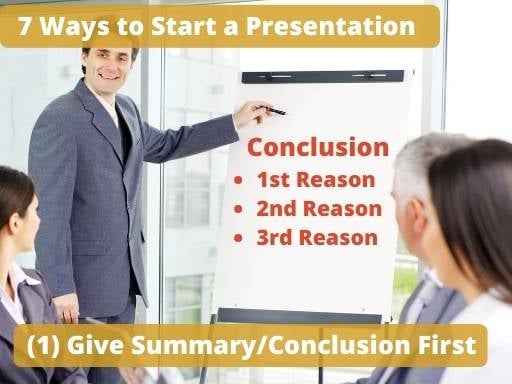
As a speaker, you have a lot going against you. The biggest challenge is that most of the people who are in your audience would really rather be somewhere else. So starting with the conclusion gives them a reason to tune in and pay attention to the content.
TV shows and movies do this a lot. The first scene in Titanic is 90-year-old Rose wheeling onto the salvage ship. Immediately, she asked the Captain to see her painting. “Wasn’t I a dish?”
We all know the story of Titanic, but by starting 70 years into the future, we already know that somehow, Rose was going to survive the tragedy. We pay attention because we want to see how she did it.
You probably also recall Netflix series that show a quick introduction and then a flashback to an earlier time.
You can create the same effect in your presentation introduction by making your title a conclusion that you want the audience to draw. Then, lay out each main point that will help them come to that conclusion.
For instance, “My topic today is Five Ways to Get Your Executives to Increase Your Department Budget, and the items we will cover are…” Of course, this technique works best when your title is a result that your audience really wants.
This is an easy way to start a presentation. You can use a single PowerPoint presentation slide as a visual aid to capture the audience’s attention right away! (FYI, you can also use this technique at the end of a presentation.)
More details about this are in Start with a Great Title.
(2) Start the Presentation with a Compelling Story
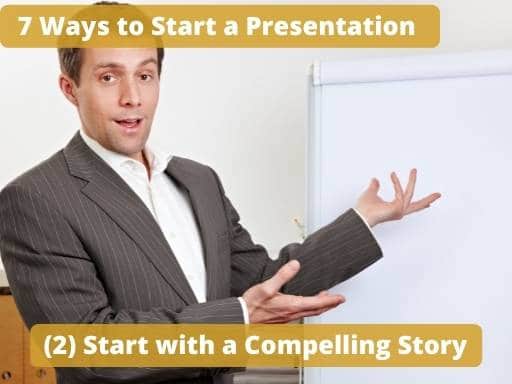
I taught a private presentation class for Mitsubishi once. And I could tell walking into the room that this was going to be a tough crowd. The culture of the predominately Japanese company is fairly quiet and conservative. Most often, when I introduce myself to class members, people are warm and friendly. Since I’m a guest in their office, most try to make me feel at home.
By the way, the Mitsubishi organizer did this here as well. However, as the participants came into the room, each walked in without saying a word. Each sat down, opened their laptops, and quietly began typing on their keyboards.
I did my best to try to get them to open up. But very few of them were laughing at my jokes or smiling at me as I asked them questions. (Tough crowd.)
So, when I started the class, I knew I needed something that would help the group relate to me. I decided to go into a fairly detailed version of an experience where I totally bombed a speech. I added a lot of self-deprecating humor to the story. Afterward, the mood in the room lightened quite a bit. It was an easy way to get the audience to feel more at ease and become more relatable to them.
Stories are easy additions to any speech. For instance, if you are giving a project report, you can start with a memorable event that occurred on the project since the last meeting. Or, if you are giving a financial report where profit is up, just give a great example of something that caused profit to increase.
(3) Or You Could Use a Startling Statistic to Start a Presentation.

By doing a little research, you can often find a good (and or startling) statistic that can capture attention quickly. You can also create a good introduction by phrasing the statistic as a provocative statement.
For instance, let’s say you are giving a financial presentation where revenue for your company was up 2.5% last quarter. You might look up the statistics for your industry as a whole in the same quarter. Then, you can start your speech with that data. “The electronics industry as a whole was up 3.4% last quarter. However, our company underperformed the industry with only a 2.5% increase in revenue.”
The easiest way to find statistics about your topic is to just do a Google search [Your Topic} followed by the word “statistic”.
Here Are a Few Examples of Using Google to Get Shocking Statistics.
I’ll give some examples. I just did a Google search for “Popular Ted Talks” and came up with an article about the Top 25 Most Shared Ted Talk videos. I just pasted the names of the talks into Google with the word “statistic” added and this is what I came up with.
- Does School Kill Creativity? According to the Adobe® State of Create global benchmark study, 8 in 10 people feel that unlocking creativity is critical to economic growth and more than half of those surveyed feel that creativity is being stifled by their education systems.
- Your Body Language May Shape Who You Are – We receive 82% of information from what we see, 11% from what we hear, and only 7% by all the other senses combined. (The Body Language Info-graphic.)
- How Great Leaders Inspire Action – 84% of organizations anticipate a shortfall in leaders within the next five years. (13 Shocking Leadership Development Statistics.)
So, it is really easy to create compelling statistics to get your audience to think differently about your topic just as you begin to speak.
Bonus Tip: Combine More than One of these Intros for Even More Impact.
You can combine the last two tips for even more impact. Place a statistic along with a story of how you found the statistic at the beginning of your presentation. This is a great way to start your presentation. “I remember watching Jerry Seinfeld do a stand-up bit. He mentioned that the fear of public speaking was the number one fear in America. Then he looked down the list and saw that the fear of death was number five. So, you are five times more likely to rather be in the casket than up giving the eulogy at a funeral.”
The key to each of these first tips is that they increase the retention of information for your audience.
For instance, using the Summary technique, you give your audience an introduction with your presentation topic and key points. Then as you go through each point, they hear each one again. Finally, you summarize the points one more time at the end of your presentation. The audience is now more likely to remember your important points. because of this subtle repetition.
A good story will also increase retention. Stories have a way of creating visual images in the mind of the audience that is more memorable than just facts alone. A startling statistic gets the audience to think, “Is that really true?” so they pay attention more.
Quick Presentation Starters to Capture Attention
(4) A Funny or Motivational Quote or One-Liner.
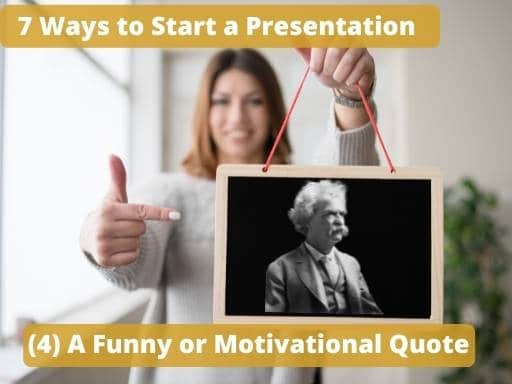
“There are two types of speakers: Those who get nervous and those who are liars.” — Mark Twain
A powerful quote is an effective way to make a positive first impression. It also adds a little humor. You can find quotes like this for your presentations as well. Just like with statistics, you can Google your topic with the word “quotes” to get ideas.
- Does School Kill Creativity? – “Creativity is the greatest expression of liberty.” — Bryant H. McGill
- Your Body Language May Shape Who You Are. – “Language is a more recent technology. Your body language, your eyes, your energy will come through to your audience before you even start speaking.” — Peter Guber
- How Great Leaders Inspire Action. – “A leader is the one, who knows the way, goes the way and show the way” — John Maxwell
Bonus Tip: Reference a quote, and then add your own take to the quote.
Walt Disney once said, “If you can dream it, you can do it.” But have you ever thought to realize that every single invention ever created by man was once just an idea born from someone’s need?
(5) Start with an Opinion Asking Question.
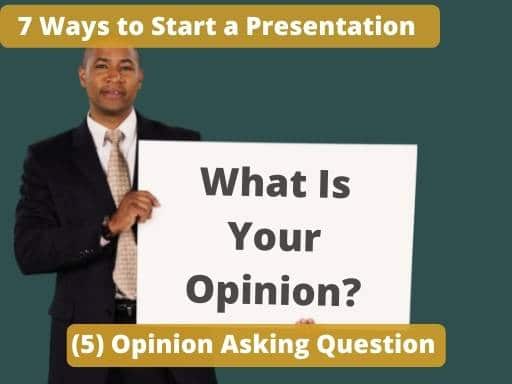
“In a perfect world, if your team was able to present their ideas to your customers more effectively, what would they be doing that they are not doing now?”
This technique is more challenging for a presenter. You have to be able to take whatever your audience gives you and design a killer presentation on the fly. However, if you have done good research before the meeting, you shouldn’t be surprised by the answers you get.
Keep in mind that only the best presenters use this technique. So, when you add open-ended questions to your speech, you will increase your stature as a speaker as well.
By the way, the question should be open-ended, meaning that the audience is giving you their opinions. Rhetorical questions and show of hands questions can backfire. Your audience may think you are trying to manipulate them. So, the important thing to remember is to ask a question that asks for the opinion of the audience members. That way, as they answer, everyone can be correct..
(6) Make a Powerful or Shocking Statement to Start a Speech.
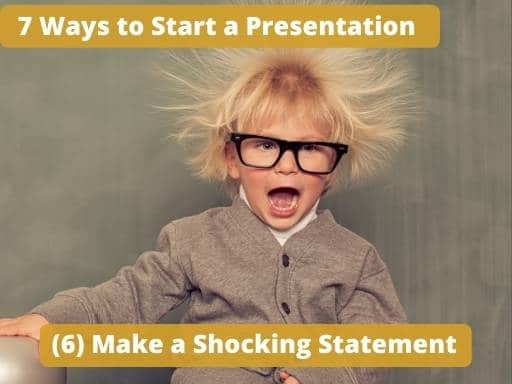
I will then follow this statement with a list of different tips that people try that don’t work really well. (Things like picturing your audience naked.)
The funny thing is that many of the people in the room will question the truthfulness of the statement the first time I say it. It is a bold claim. They don’t confront me, though. However, when I look around the room, I can see the distrust on their faces.
However, as I begin to list the crazy tips one by one, they begin to realize the truthfulness of the statement. Internally, the checklist sounds like this…
- To reduce nervousness, you should pretend your audience is naked. (Man, he’s right. I tried that. It doesn’t work.)
- You should memorize your speech word-for-word. Actually, if you lose your place when reciting the speech, you just get more nervous. (That one is true too.)
- You should practice in front of a mirror or record yourself speaking. Actually, you are your own worst critic. You will nitpick every little thing that you do wrong. (Yup, I’ve done that one too. Wow, maybe he’s right. Those things don’t work at all.)
Another shocking statement I use is to foreshadow a future behavior in the speech. When I lead team activities, I often have them play a game to divide into teams. So, I might start the presentation with, “In less than 15 minutes, some of you chivalrous men who opened a door for a young lady when she came into the room will actually be chicken-winging that woman to take something from her.” Of course, when something like that actually happens, everyone erupts in laughter.
(7) Arouse Curiosity with a Hook.

Talk radio, television news, and reality TV shows do this brilliantly.
I remember years ago watching season one of Survivor. The season winner was an eccentric guy named Richard Hatch, who was a good fisherman, so he fed the group. However, he also did things to keep the other contestants a little off their game. At the start of one of the episodes, Richard was walking along the beach buck-naked with his bottom blurred out by the producers.
I remember doing a double-take when the image came on the screen. (There are some things that you just can’t unsee.) I didn’t particularly ever want to see Hatch’s bare bum ever again. However, I had an eager want to find how the heck this happened.
Talk radio guys do this by saying, “At the bottom of the hour, we’re going to…” The technique is like a cliffhanger. Everyone wants to know how the story will end. Will Ross marry Emily, or will Rachel stop the wedding? Will Jon Snow die of his stab wounds? Ken Jennings has won 74 times in a row on Jeopardy. When will he get beaten? What is going to happen now that DEA agent Hank realizes his brother-in-law broke bad? And finally, who shot J.R.?
How to Easily Add a Hook into the Start of Your Presentation.
This is a fun technique to use when you start a presentation. And there are many different ways to do this, depending on the purpose of your presentation.
For instance, you could tell your compelling story, as I suggested earlier. However, don’t tell the ending. Stop right as you get to the climax. Then tell the ending in your conclusion. (More details about this in How to End a Speech.)
Or, the hook can be a cliffhanger or foreshadowing of something later in the presentation. “As we did this research, we uncovered a single habit that, once we change it, will generate an extra quarter of a million dollars for our company. And I will share that secret with you in my final point.”
I actually do this on my podcast as well. I might start the episode by saying something like, “In the last ten minutes of this episode, I’m going to share with you my best, overall, foolproof presentation opener.”
(Which, by the way, is right now…)
A Bonus Way to Start a Presentation Is to Add Showmanship. (Bonus… Not a Foolproof Way.)

For instance, one time, just after July 4th, my kids had some leftover fireworks. I also had some decorative mailing tubes left over from a failed marketing campaign.
The next morning, I was to speak at a business breakfast. I got to the hotel meeting room before anyone else and filled a trash can with water. Then, I left the can under the presentation table at the front of the room. I stuck one of the sparklers into the top of the mailing tube and waited until my time to speak. The emcee called my name, and I waited at the back of the room. She called my name one more time, and I waited just a bit longer. When she called my name the third time, I lit the sparkler and went rushing to the front of the room.
Of course, the visual aid looked like I was holding a stick of cartoon dynamite. I pulled the trash can from under the table and threw the prop into the can where it sizzled and smoked. The whole audience was looking around like, “What the heck?” I paused and then said, “Do you want to put some sizzle into your presentations?”
Okay, it was cheesy. It was over the top. But it got the whole audience laughing. Everyone in the room remembered who I was and what I did for a living.
A few less over-the-top ways of adding showmanship into your presentation might be…
- Use Boards Instead of Slides. Everyone expects a slideshow, but if you have a compelling board or poster that is in the front of the room when you start, you can create some curiosity about your topic.
- You Could Also Get the Audience to Participate in a Demonstration. I had a saleperson from the Riddell helmet company tell us about a football helmet face-mask that could detach with a simple pencil-like tool. He had a couple of men try to pull the face-mask off the helmet and when they failed, he used the tool to remove the mask with one hand. It was a vivid demonstration.
- Or Just Add a Funny Video. When I teach leadership classes, I often play segments from old Saturday Night Live skits that have the characters doing the exact opposite of what I’m teaching. For instance, I might start a session about avoiding criticism in the workplace with an episode of “Debbie Downer”.
Whatever method that you choose to start your presentation make sure to spend time on developing your content. You don’t want to spend a ton of time creating the perfect opener and then lose the audience with a lackluster presentation afterward.

